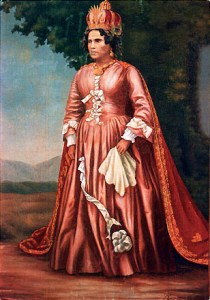
Queen Ranavalona I of Madagascar was born in 1778 and named Rabodoandrianampoinimerina. She married King Radama and was one of his twelve wives. When he died in July 1828, she was his highest-ranking wife and so inherited the throne, becoming the first female monarch since 1540. She was visibly pregnant at her ascension to power, visually re-enforcing the unique nature of her rule in Merina history.
The empire she inherited had been built under Radama and comprised formerly small and isolated kingdoms. She carried on his plans to build Merina – the largest ethnic group in Madagascar – into an empire, though Ranavalona intended to do so independently from European influence. She rejected Christian and European traditions largely due to her own cultural belief of Hasina, in which each nation is devoted to their ancestors and stays true to their ancestral traditions. As a result of her anti-European sentiments, she’s often portrayed negatively in the Western world.
During her reign, she created a professional standing army of 20,000-30,000 members and repelled a joint French and British attack at Tamatave in 1845. She’s known for fostering a bureaucratic administration, encouraging an industrial economy, banning Christianity and ejecting all London Missionary Society missionaries from Madagascar, and expelling the resident British agent in Madagascar.
She survived a coup attempt by her son Prince Rakoto and a further attempted coup in 1857, ultimately dying in power in August 1861.
Recommended Reading
Arianne Chernock, “Queen Victoria and the “Bloody Mary of Madagascar”,” Victorian Studies 55.3 (2013): 425-449
Emma Marriott, Long Live the Queens: Mighty, Magnificent and Bloody Marvellous Monarchs History’s Forgotten (London: HarperCollins Publishers, 2019)
Gerald M. Berg, “Ranavalona, the Ancestral Bureaucrat,” History in Africa 22 (1995): 73-92.
